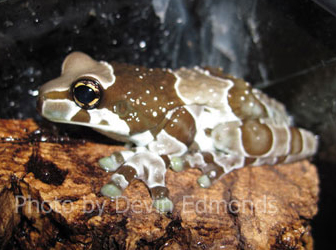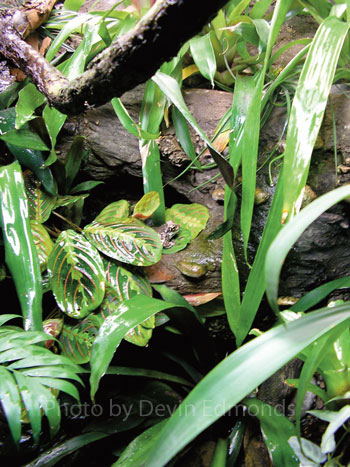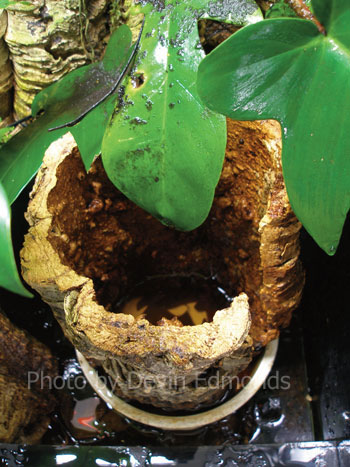If you are searching for a new amphibian pet or project, take some time to consider milk frogs
Few popular amphibian species in today’s herpetocultural mainstream have as interesting and unusual a life history as the milk frog (Trachycephalus resinifictrix). In nature, they live and breed exclusively in the canopy of Amazon rain forests, as high as 100 feet above ground. Males compete in their arboreal homes for water-filled tree holes, which are the only places they breed. In these holes, tadpoles develop and often cannibalize their own species’ eggs for food. Add to this the defensive milky skin secretions for which T. resinifictrix gets its common name, and you have a very cool frog to keep in captivity.
You might expect a species with such specific and unique characteristics in the wild to be difficult to maintain, but not the milk frog. These are fun, hardy and robust amphibians that have been compared to the popular White’s tree frog (Litoria caerulea) in their care. Properly kept milk frogs may live to be 8 years old or more. While you’ll want a basic understanding of amphibian captive husbandry under your belt before working with them, milk frogs are by no means difficult, and they can even breed fairly easily given the right setup.

Photo by Devin Edmonds.
Light gray to white polka dots eventually develop and speckle most of the dark dorsal coloration of adult milk frogs.
Creamy Coloration
Perhaps much of the popularity the milk frog has gained in recent years is a result of its attractive coloration. Most often found for sale as sharply patterned black-and-white banded juveniles, their contrasting coloration blends into a mix of more subtle browns and grays, outlined in crisp white as they mature during the first couple years. Light gray to white polka dots eventually develop and speckle most of the dark dorsal coloration as adults.
Like many tree frogs, adult male milk frogs are substantially smaller than females and rarely exceed 21/2 inches in length. Females, on the other hand, can grow to 4 inches or more. Males also have loud calls, which they use to attract mates and defend breeding sites. Milk frogs are hearty amphibians, with muscular limbs and bulky hands. At the tip of each toe is a fat toe-pad for climbing that often appears a subtle shade of turquoise, especially when viewed from underneath as a frog is climbing on the terrarium glass at night.
Acquisition
Milk frogs can be purchased directly from breeders, and they can also be found for sale through herp dealers and specialty pet stores. Nearly all milk frogs in the trade are captive-bred animals, as most countries in the Amazon, where milk frogs naturally occur, no longer regularly export wild-caught amphibians. The first successful captive breeding of this species was not so long ago; in fact, it was described earliest in the April 1998 edition of REPTILES magazine. Given that captive-bred stock is regularly available, many common problems associated with obtaining wild-caught animals can be avoided. Still, it’s important to inspect individuals carefully before purchase.
Avoid buying freshly metamorphosed frogs. As cute and colorful as they are, small froglets can also be more sensitive and trickier to maintain than larger juveniles. Opt for purchasing frogs that measure around 1 inch in length or more. Healthy milk frogs should be asleep during the day, usually perched above ground unless they have recently been fed. They should also look somewhat rotund. Milk frogs are not slender, lanky frogs like the popular red-eyed tree frog. They are fat and heavyset, more like a White’s tree frog.
Simplistic Setups
Before acquiring milk frogs, it is a good idea to set up their housing at least a week in advance. This will allow you to monitor the conditions inside and ensure they are adequate before frogs are introduced.

Photo by Devin Edmonds
An adult pair can be maintained in a 20-gallon aquarium, while a group of five shouldn’t be kept in anything smaller than an enclosure measuring 24 inches long, 18 inches wide and 24 inches tall.
A standard, 10-gallon aquarium provides enough room to house up to five juveniles. Adults will need more room. An adult pair can be maintained in a 20-gallon aquarium, while a group of five shouldn’t be kept in anything smaller than an enclosure measuring 24 inches long, 18 inches wide and 24 inches tall. Large, plastic storage boxes have also been used to house milk frogs successfully. Good ventilation is important for both glass and plastic housing, so make sure to use a screen cover to allow adequate airflow. Conditions in the canopy of the rain forests of South America are humid but never stagnant, and a terrarium for milk frogs should reflect this.
The easiest way to maintain milk frogs is in a simple, hygienic housing style. Because of their arboreal nature, no substrate is needed as long as the bottom of the enclosure is rinsed with water to remove waste frequently. Alternatively, you can use a layer of moist paper towels as a substrate, but these will need to be replaced several times a week. Moist sphagnum moss patted down flat over a layer of gravel for drainage can also be used as a substrate and will require less frequent replacement than paper towels.
Watering Hole
A large water dish will serve as your frog’s water-filled tree hole, near which milk frogs spend much of their time in the wild. In nature, these holes are often quite large. One field study found the average diameter of occupied holes to be more than 17 inches, and the average water volume within to be nearly 5 gallons! Don’t skimp on the water dish. If you give your frogs a big one, they will happily soak in it every night.

Photo by Devin Edmonds.
Placing the end of a cork bark tube into a water dish of similar diameter will replicate the water-filled tree holes that milk frogs occupy in the wild.
Water quality is important for amphibians, so make certain to only use tap water that has been dechlorinated. You can remove chlorine and chloramines from tap water with aquarium products that are available in the fish department of pet stores. It is best to let water sit for a day after being treated to fully allow gases to dissipate and chlorine and chloramines to be fully neutralized. If you suspect the tap water in your area is of poor quality and not suitable for frogs, some brands of bottled spring water are safe to use.
Large, hollow cork bark tubes form easily cleaned perches and shelters. You can position several of these at various angles within the enclosure by leaning them against the walls of the enclosure. Bamboo poles or PVC pipe can be used, as well. To create a naturalistic tree hole, insert the base of a large cork bark tube into a water dish of similar diameter.
Spruce It Up
It is possible to include live plants in a milk frog enclosure, even a very basic one such as I’ve described. Use broad-leafed epiphytes that are sturdy and can support the weight of a milk frog. My milk frogs would frequently spend the days asleep within the axils of large Neoregelia bromeliads. Broad-leafed varieties of Philodendron also work well. These plants can be grown in pots or epiphytically attached to cork bark or cork bark tubes with sphagnum moss tied in place at the base of the plant with fishing line. If you don’t have a green thumb, or simply would prefer not to deal with live plants, artificial ones will work just the same. Or you can skip the plants entirely.
Let There Be Light (and UVB) For Your Amazon Milk Frog
While these days it is quite standard practice to provide light that emits UVB radiation to many reptiles to allow calcium to be properly utilized and prevent metabolic bone disease (MBD), few studies have been conducted on captive amphibians to see the affects of UVB on frogs. In this regard, milk frogs stand alone. Recent work has, in fact, been carried out to look at the differences between juvenile milk frogs raised with UVB lighting and those without. The result? Milk frogs raised with UVB lighting grew larger and had healthier skeletons.
Many people have kept and even bred milk frogs successfully without providing UVB lighting. The frogs live, they grow and they survive. However, given the recent increase in our knowledge about how UVB affects the growth of milk frogs, it would be wise to provide UVB radiation to captive milk frogs if you plan to offer the best care possible.
Use a fluorescent tube that emits UVB radiation of either 2.0 or 5.0 strength, and place it over a screened section of the enclosure. Remember that the amount of UVB radiation emitted by lights decreases with time, and they must be replaced annually even though they still light up. Also, take into consideration that if the bulb is more than a foot or two away from where the frogs spend most of each day, they will receive very little benefit from the light, as the amount of UVB received decreases the farther away a frog is from the bulb.
In addition to UVB lighting, you may also want to provide a standard fluorescent tube that has a color temperature of between 5,000 and 6,500 Kelvin to offset the unnatural purple or blue glow of the UVB light. All fluorescent lights should be placed on an automatic timer that is set to provide light for around 12 hours each day.
Replicating a Rain Forest Environment For Your Frog
Temperature is important for captive amphibians, and it is one of the most common areas where mistakes are made. Before adding or removing heat sources, make sure you are using an accurate thermometer to measure the temperature. This should not be positioned in just one area of the enclosure; position a few in different areas of the enclosure.
In the canopy of the Amazon rain forest, milk frogs can choose whether they want to shelter in a dark cool tree hole or sit on a branch in the warm sun. Replicate this in the terrarium. During the day, the coolest areas of the enclosure can stay between 70 and 75 degrees Fahrenheit while the warmest areas near the light source can reach 85 degrees. At night, the temperature can drop to 65 degrees without problems. Occasional days outside these ranges can be tolerated by healthy milk frogs so long as normal temperatures are restored soon after.
A low-wattage, incandescent spotlight can be added for heat over the screen cover of the terrarium if the temperature is too low. Lights made of red glass can be left on and used for heating at night. Avoid heat pads, hot rocks or heating cables, especially if you are not using a substrate, as in this case, they could harm the frogs.
Humidity levels are not as important as getting the temperature right, but take care to mist the terrarium with water at least once a day. You can use dechlorinated tap water for misting or go for reverse osmosis water if you don’t want water spots to develop on the glass. By misting the terrarium once or twice daily you can provide a temporary increase in humidity where the level reaches nearly 100 percent, followed by a decrease to more normal ambient humidity levels that stay between 50 and 90 percent.
Breed Amazon Milk Frogs
Learn how to breed Amazon milk frogs by visiting ReptileChannel.com/BreedMilk
Eager Eaters
Perhaps the most enjoyable aspect of keeping milk frogs is feeding them. These are gluttonous, greedy and rarely fussy frogs. Growing juveniles should be fed once per day, while adults can be fed twice per week or less frequently. Although milk frogs are predominantly nocturnal, most learn to wake up and feed during the day if food is available. Feed between three and 10 food items per frog, depending on the size of the food and the size of the frog.
Providing a variety of food items is key to long-term success. Crickets can make up a large part of the diet. These should be about as long as the width of the frog’s head. Other food items, such as house flies, earthworms, wax worms and small roaches (Blaberus craniifer have been used, but other roach species would also probably work) should be offered every three to five feedings to vary the diet. Juvenile frogs will also eat flightless fruit flies, and large adults can eat pinky mice, but mice should be fed sparingly, if at all.
Use a powdered nutritional supplement that is phosphorus-free and contains calcium, vitamin D3 and vitamin A. Coat food items with this supplement at every feeding for juvenile frogs. For adult frogs, use it on food items every other feeding or so.
Milk Frog Maintenance
Routine care for milk frogs is not time consuming or difficult, but it is important that you are diligent and do not neglect important aspects of their husbandry. Cleanliness is of upmost importance. Replace the water in the water dish every day. Additionally, remove feces, dead food items and other waste from the enclosure daily. You should also check the temperature frequently to make sure it is within a suitable range.
At least every few weeks, remove all frogs and inspect their condition. Make sure they look like they are maintaining a good weight and are healthy. While the frogs are removed, you can take out all hiding spots, plants and the water dish and rinse them off. Never use soaps or detergents for cleaning because leftover residues can harm amphibians. Instead, use hot water to help remove waste from perches and the terrarium.
Conclusion
If you are searching for a new amphibian pet or project, take some time to consider milk frogs. They’re not your average tree frog. With an interesting and unique natural history but simple care requirements, milk frogs make exceptionally rewarding captives. REPTILES
DEVIN EDMONDS has kept amphibians since childhood. He is working toward a degree in zoology at the University of Wisconsin-Madison to help him further understand these animals. He also runs a popular website about their captive care: www.amphibiancare.com.


